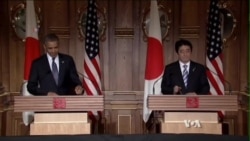U.S. officials say Japan’s Prime Minister Shinzo Abe's visit to the United States next week will be historic, signaling a new phase in the trans-Pacific alliance in the face of China’s growing military and economic power in the Asia Pacific region.
White House officials have planned a welcome with the pomp and circumstance reserved only for the most distinguished of visiting heads of state. There will be a lavish welcome ceremony on the White House lawn, a joint news conference with President Barack Obama and a state dinner.
Perhaps the biggest honor: Shinzo Abe will be the first Japanese prime minister to address a joint meeting of Congress. The last time a Japanese head of state addressed U.S. lawmakers was in 1961, when Prime Minister Hayato Ikeda spoke before members of the House of Representatives.
U.S. officials say the welcome is fitting for a year that marks the 70th anniversary of the signing of peace between two nations that were bitter enemies during World War II but have since become strong trading partners and close military allies.
So close is the partnership that the U.S. is obliged to provide for Japan’s defense and protect it from foreign enemies under a treaty signed six years after Japan’s surrender in World War II.
With China expanding its military and asserting claims over the Senkaku islands in the East China Sea that are also claimed by Japan, Tokyo feels threatened. Last year, Japanese leaders welcomed President Obama’s remarks when he reaffirmed U.S. obligations under the 1951 Security Treaty between the United States and Japan during a visit to Japan.
“Let me reiterate that our treaty commitment to Japan's security is absolute,” he said, adding that Article 5 of the treaty covers all territories under Japan's administration, “including the Senkaku Islands.”
But cuts to the U.S. defense budget and lingering U.S. economic weakness have fed doubts among some Japanese, as have questions about whether the United States is carrying out its plan to rebalance forces to the Asia Pacific. The Obama administration announced the plan four years ago, aiming to pivot Washington’s focus away from Middle East conflicts to the Asia Pacific region.
As China increases military spending and continues to assert maritime claims, the U.S. wants to reassure Japan.
“I think one of the things that the U.S. definitely wants to do is to send a strong signal, not only to China, but also to the rest of the region and to the Japanese people that we value the alliance,” says Meredith Miller, an analyst with the National Bureau of Asian Research, a Washington think tank.
U.S. officials say trade is an important part of their rebalance to the Pacific. They are eager to continue making progress toward a 12-nation trade bloc in which the U.S. and Japan - as the largest economies - would dominate.
“One high-profile topic on the agenda will be the status of the Trans-Pacific Partnership negotiations,” White House spokesman Josh Earnest told reporters.
Since tensions began escalating over Beijing’s claims in the East China Sea, the Japanese have been reexamining their defense structure, and advisers to Prime Minister Abe have recommended that Japan interpret its constitution to allow for Japan’s limited self-defense force to assume greater responsibility for the country’s security.
An announcement is expected soon, updating Japan’s defense guidelines for the first time in 18 years, something analyst Miller says will be a sign of a changing landscape in East Asia.
To Miller, this represents a significant development. “This is a really step in terms of bringing those into the future, into the reality of the world that the U.S. and Japan both face right now in terms of thinking about security challenges,” she said.








